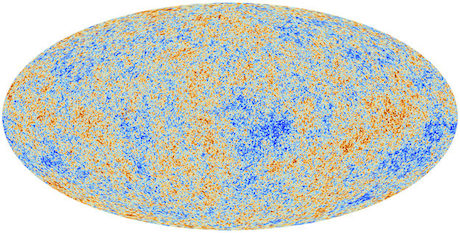Специалисты по космологии давно пытаются реконструировать полную историю Вселенной, имея всего несколько проверенных отправных точек для своих исследований. Одна из них — распределение материи, формировавшееся силами гравитации и расширением пространства на протяжении примерно 14 миллиардов лет.
Распределение материи во Вселенной стало предметом оживлённых дебатов: равномерно ли оно, или наш космос состоит из отдельных образований, структурированных по иерархическому принципу — подобно фракталам. Анализ данных о примерно миллионе галактик предполагает, что фрактальное устройство вполне возможно, хотя до сих пор нет общепринятых теорий, которые могли бы его объяснить.
Две точки зрения
Почти все физики согласны в том, что в относительно малых масштабах распределение материи подобно фракталу: тысячи звёзд сгруппированы в галактики, галактики формируют кластеры, а кластеры образуют суперкластеры.
Но сохраняется ли этот принцип при больших масштабах? Сегодня большинство физиков склоняется к тому, что организация материи по принципу «матрёшки» на определённом этапе заканчивается, и в большом масштабе Вселенная оказывается однородной.
Однако небольшая группа физиков из Италии, включая Франческо Лабини и Лучано Пьетронеро, считают, что имеющиеся данные говорят о другом: большая часть Вселенной устроена как фрактал. По крайней мере, до тех пределов, которые поддаются нашему наблюдению.
3D-карты
Лучшие на сегодня данные, позволяющие оценить распределение галактик, мы получаем благодаря проекту «Sloan Digital Sky Survey» (SDSS), который занимается конструированием самой большой 3D-карты Вселенной. В законченном виде эта карта отразит положение примерно миллиона галактик и квазаров.
Когда были опубликованы первые данные проекта «SDSS», американские физики, проанализировав 55 тысяч светящихся красных галактик, предположили, что фрактальное устройство ограничивается масштабами в 200 миллионов световых лет.
Но итальянских учёных это не убедило. Они уверены, что этот предел – всего лишь иллюзия, вызванная недостатком статистических данных, и окончательный вывод можно сделать, только имея более масштабную карту для анализа. В настоящий момент проект «SDSS» содержит информацию о примерно 800 тысячах галактик и 100 тысячах квазаров, но и этого пока недостаточно.
В больших масштабах
В своей недавней статье, написанной совместно c физиками Санкт-Петербургского государственного университета, Лабини и Пьетронеро приводят свежие данные о том, что галактики проявляют фрактальные свойства вплоть до пределов в 100 миллионов световых лет.
По их утверждению, даже если Вселенная в определенной точке становится однородной, то только на отрезке в 300 миллионов световых лет в диаметре. Но даже при этом масштабе всё ещё наблюдаются колебания в распределении материи — скопления перемежаются пустотами. Большинство космологов считают эти колебания незначительными, подобно крошечным волнам на поверхности моря, однако Лабини с коллегами сравнивают их с цунами.
Модели всё ещё нет
Сохранение фрактального принципа распределения материи даже при таких огромных масштабах ставит под сомнение стандартные модели космологии. Согласно общепринятой истории космической эволюции прошло ещё недостаточно времени с момента Большого взрыва, чтобы силы гравитации могли выстроить такие крупные структуры.
Более того, предположение, что материя во Вселенной распределена однородно, позволяло космологам моделировать Вселенную, основываясь лишь на Общей теории относительности Эйнштейна, задающей зависимость распределения материи от формы пространства.
Смоделировать фрактальную Вселенную с помощью ОТО теоретически возможно, но на практике модель эта будет неизмеримо сложной. Так что согласиться с предположением о фрактальном устройстве Вселенной для физиков означает остаться без рабочей космологической модели.
Реликтовое излучение
В поддержку гипотезы об однородности Вселенной космологи также упоминают равномерность распределения реликтового электромагнитного излучения, существующего с момента рождения Вселенной. Многочисленные исследования, отражающие данные о фоновой космической радиации, рентгеновском излучении и радиогалактиках подтверждают, что на ранних этапах своего развития Вселенная была практически однородной. И если эти данные противоречат результатам оптических наблюдений, то этому можно найти достаточно объяснений, не прибегая к теории фрактальной Вселенной.
Оптическая иллюзия
Но сделать заключение о распределении материи только по реликтовому излучению совсем не просто. Имеющиеся результаты попыток картографировать его распределение – это проекции на плоскость, так что возможно такая равномерность возникает именно благодаря особенностям переноса реального пространства на плоскую карту. То же самое касается и фонового рентгеновского излучения, которое также кажется однородным в двумерной проекции. И, наконец, использовать радиогалактики также затруднительно, поскольку сложно измерить расстояние между ними достаточно точно, чтобы отобразить их расположение на 3D-карте.
Так что же может производить такую фрактальную структуру, которую обнаруживают некоторые исследования? Наблюдение отдельных скоплений вполне могут быть результатом оптической иллюзии, известной как эффект «бычьего глаза».
Он возникает потому, что близлежащие галактики стремятся друг к другу в силу общего гравитационного притяжения, не смотря на то, что пространство само по себе расширяется. Это движение может усиливатьвидимые скопления материи, наблюдаемые в исследованиях, подобных проекту SDSS, особенно потому, что подобные исследования построены на измерении скорости вращения галактик на основании расчёта их расстояния от Земли.
Команда Лабини утверждает, что эффект «бычьего глаза» имеет значение только при очень малых масштабах, примерно 16 миллионов световых лет и меньше, и не влияет на скопления при больших расстояниях.
Ставки сделаны
Так каковы же будут последствия, если подтвердится, что Вселенная действительно имеет фрактальную структуру? Кроме радикального пересмотра законов и истории формирования Вселенной, это будет иметь и некоторые более приземлённые последствия.
Больше десяти лет назад Лабини и Пьетронеро заключили пари с физиком Марком Дэвисом из Калифорнийского университета. Если распределение галактик окажется фрактальным при масштабах примерно в 50 миллионов световых лет, Дэвис будет должен итальянским коллегам ящик калифорнийского вина. Если же фрактальный принцип нарушится при масштабах менее 50 миллионов световых лет, тогда уже Дэвису причитается ящик итальянского.
Источник: http://gearmix.ru/archives/1473




